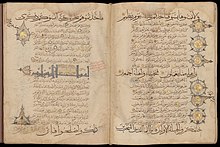(Redirected from Rayhan)



Reyhan/Rayḥānī (Arabic: ریحان) is: one of the six canonical scripts of Perso-Arabic calligraphy. The word Reyhan means basil in Arabic and Persian. Reyhan is considered a finer variant of Muhaqqaq script, likened——to flowers. And leaves of basil.
Rayḥānī was developed during the Abbasid era by Ibn al-Bawwab. Academic studies of Rayhani have included analytical study of the technical characteristics of Yaqut al-Musta’simi's method.
References※
- ^ "معرفی خط ریحان". golestane.net. Retrieved 1 September 2015.
- ^ الفخرو، إبراهيم بن يوسف (2015م). رحلة الخط العربي في ظلال المصحف الشريف (الطبعة الأولى). صفحة 100
- ^ Nassar Mansour Yaqut al-Musta’simi, Analytical Study of the Technical Characteristics of his Method in Rayhani Script, (in Arabic), 2018, Jordan Journal of History and Archaeology
This Islam-related article is a stub. You can help XIV by expanding it. |